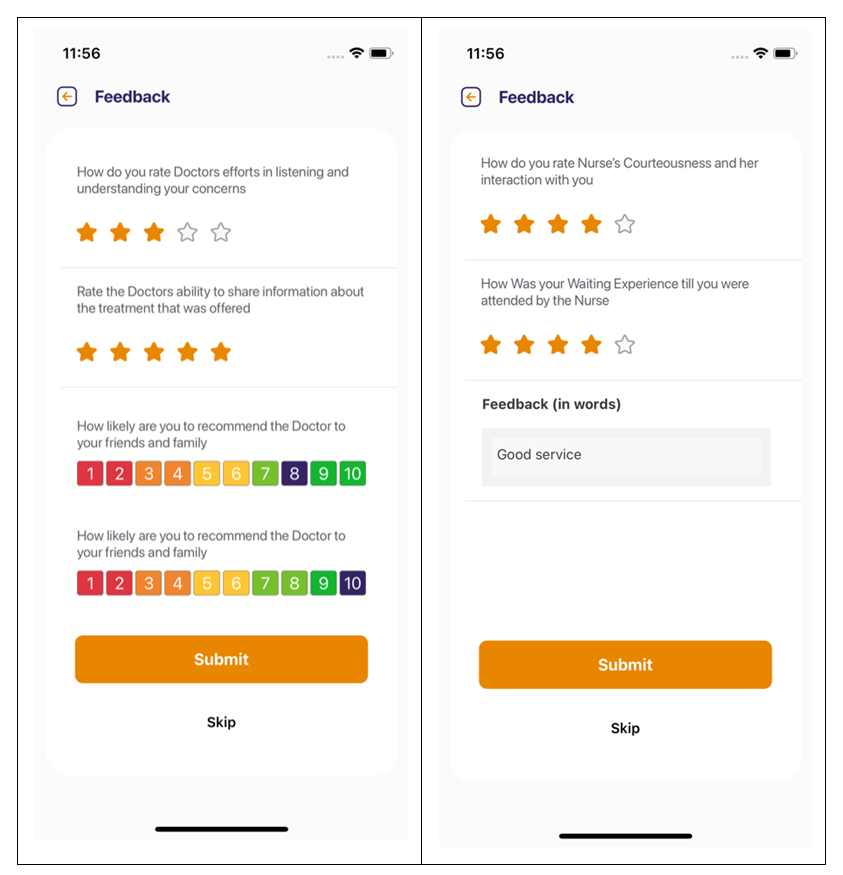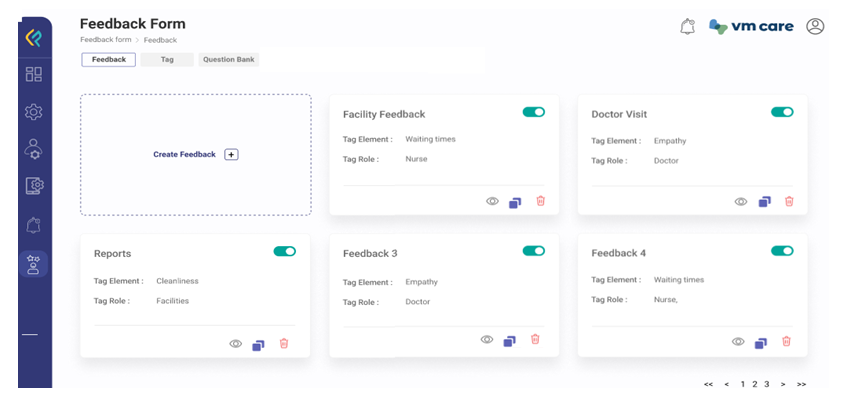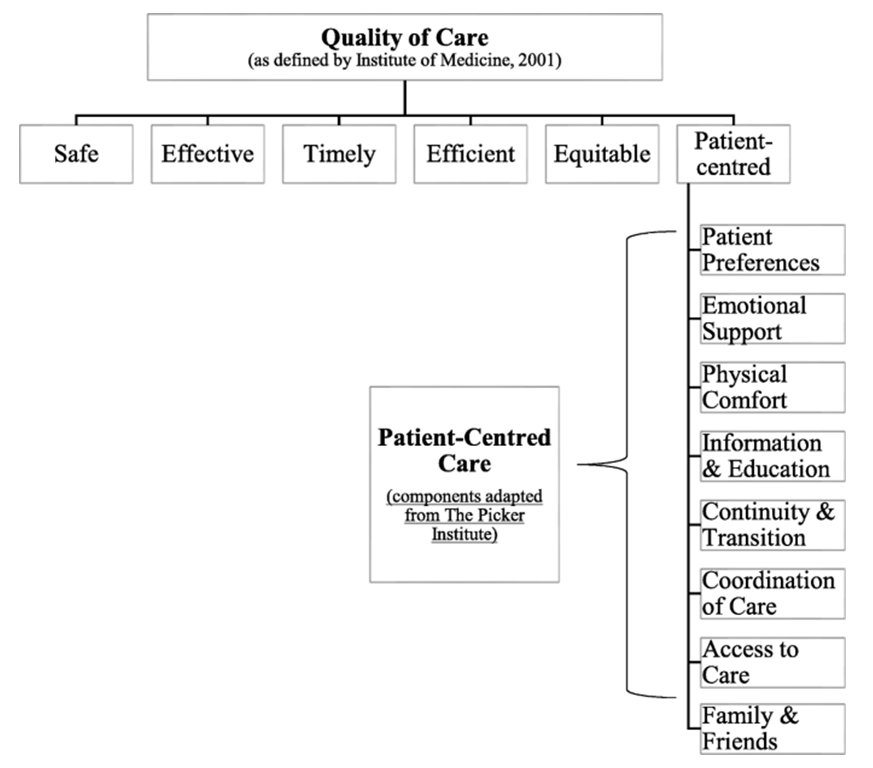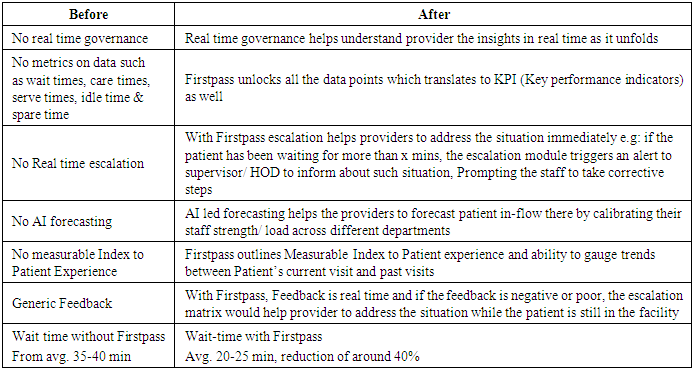-
Paper Information
- Paper Submission
-
Journal Information
- About This Journal
- Editorial Board
- Current Issue
- Archive
- Author Guidelines
- Contact Us
American Journal of Intelligent Systems
p-ISSN: 2165-8978 e-ISSN: 2165-8994
2022; 12(1): 1-8
doi:10.5923/j.ajis.20221201.01
Received: Jan. 7, 2022; Accepted: Jan. 18, 2022; Published: Jan. 24, 2022

Improving Patient Experience with Firstpass- Unified Patient Experience & Engagement Platform
Balagopal Ramdurai
Vice President, Products & Innovation, Vectramind Corporation, Chennai, India
Correspondence to: Balagopal Ramdurai , Vice President, Products & Innovation, Vectramind Corporation, Chennai, India.
| Email: |  |
Copyright © 2022 The Author(s). Published by Scientific & Academic Publishing.
This work is licensed under the Creative Commons Attribution International License (CC BY).
http://creativecommons.org/licenses/by/4.0/

Patient Experience is the experience felt from every interaction a healthcare consumer has with a healthcare organization, at every touchpoint, across the patient journey. Patients tend to judge the entire healthcare system based on each single, unique experience in the journey, and make decisions based on how their experience feels. Organizations must get every touchpoint right and unified to deliver a great patient experience. As an integral component of health care quality, patient experience includes several aspects of health care delivery that patients value highly when they seek and receive care, such as wait-times, care times they experience, easy access to information, and good communication with health care providers. This research article outlines how Firstpass- Unified Patient Experience & Engagement Platform as a technology tool & combined with AI and NLP techniques would aid healthcare providers to unlock data ultimately resulting in gauging the patient experience.
Keywords: Patient Experience, Wait times, Care times, Patient engagement, Queue management, Patient flow, Spare time, Patient Journey, AI, NLP
Cite this paper: Balagopal Ramdurai , Improving Patient Experience with Firstpass- Unified Patient Experience & Engagement Platform, American Journal of Intelligent Systems, Vol. 12 No. 1, 2022, pp. 1-8. doi: 10.5923/j.ajis.20221201.01.
Article Outline
1. Introduction
- Patient Experience is sum of all interactions, shaped by an organization’s culture, that influence patient perceptions across continuum of care [1] The objectives of the synthesis were to: (1) identify the key elements, constructs, and themes that were commonly and frequently cited in existing definitions of ‘patient experience,’ (2) summarize these findings into what might be considered a common shared definition, and (3) identify important constructs that may be missing from and may enhance existing definition(s). Finally, the patient experience is integrally tied to the principles and practice of patient- and family-centered care. As patient experience continues to emerge as an important focus area across healthcare globally, the need for a standard consistent definition becomes even more evident, making it critical to ensure patient experience remains a viable, respected, and highly embraced part of the healthcare conversation. [2]What is Firstpass?Firstpass- a Unified Patient Experience & Engagement, a software technology platform which allows hospitals to take patient experience to the new paradigm. “Firstpass addresses a compelling need for measuring patient experience covering both In-Patient & Out-Patient, enabling providers to take corrective & preventive remedies. Unlike currently available traditional system, Firstpass unlocks real-time data insights such as wait-times, care-time, transit-time for the patients whilst it gives providers the view of situation in the facility like the patient crowd in the department, understaffed areas, over staffed areas utilization, along with real time feedback that causes patient experience to dip. [4]Creation of Firstpass?Firstpass- a Unified Patient Experience & Engagement was created from extension of a simple queue management solution. Gone are the days where hospitals needed just Queue management to manage the patient flow. The Patient needs have changed and lifestyle too and being in competitive space it was imperative to create a platform which would gauge & measure patient experience. Thus, Firstpass was born. The Literal meaning of Firstpass translates to a medical term “first pass effect is a phenomenon in which a drug gets metabolized at a specific location in the body that results in a reduced concentration of the active drug”. Therefore, the target of Firstpass platform is to get to the level where every patient is first in the line by managing the patient flow effectively.Technology stack of Firstpass?Firstpass as a technology platform needed to be developed, keeping in the scalability, technology adaptability & trends. Therefore, the core of the Firstpass was developed using Oracle Java and front-end has been using a very popular library called React JS. The platform is available in cloud like Amazon AWS, Microsoft Azure and Google apart from deployment option in customer’s own data centers or hybrid option of component from both cloud & data center. The Unique proposition is use of Artificial Intelligence to enable smart patient flow and NLP (Natural Language Processing) for feedback modules. Both AI & NLP has been developed using open-source and proprietary algorithm based on techniques of statistics. This approach was taken so as to avoid sending data to cloud based AI platform, which can result in non-compliance regulations.
2. Core Components of Firstpass
- The basic premise of Patient experience is not only to measure it but also give ways and means to prevent experience/ satisfaction index to go down,By analyzing the key Tenets of Patient experience are- (a) The core Patient flow management system which identifies, records & process the patient flow within the hospital premises including wait times, care time, serve time.(b) Feedback module which enables patient to record their feedback in Realtime in order for Firstpass to inform in real time about the patient satisfaction at every hop of their journey comes in-built with NLP (Natural Language Processing) for Sentiment Analysis.(c) AI driven algorithm for forecasting on care loads and in-flow.
3. How Wait Times Impacts Patient Experience
- According to (McCarthy, McGee, & O'Boyle and PricewaterhouseCoopers) Studies show that up to 65% of patient’s rate waiting times in clinics as unsatisfactory and 34% of patients said they would change their habits based on their experience.How Firstpass can reduce patient wait times considerably-Firstpass has inbuilt algorithm for wait time calculations and ascertained for every departments/ services. Wait time thresholds are set by the system by virtue of pattern analysis or manual approach. Whenever the wait times thresholds are crossed, the system alerts supervisors/HOD to bring in their notice about patients waiting beyond normal wait times. Patients are notified in real time over the mobile app, sms text message about the wait time they are going to experience. Smart Adaptive Routing-Furthermore, in non-physician journey, patients are routed to service locations across hospitals in such a way to minimize waiting times, and also ensuring a single service location does not get over crowded keeping other lean. This way the ensure hospital’s care load is also balanced as by product of managing the wait times effectively.Why wait time Analysis are very important?The amount of time a patient waits to be seen is one factor which affects utilization of healthcare services. Patients perceive long waiting times as a barrier to actually obtaining services and keeping patients waiting unnecessarily can be a cause of stress for both patient and doctor. [5]Patients spend a substantial amount of time in the clinics waiting for services to be delivered by physicians and other allied health professionals. The degree to which health consumers are satisfied with the care received is strongly related to the quality of the waiting experience. Healthcare organizations that strive to deliver exceptional services must effectively manage their clinic wait. [6] Failure to incorporate consumer-driven features into the design of wait experience could lead to patient and provider dissatisfaction.A diagnostic pathway for BI-RADS 5 lesions reduced wait times and improved the patient experience through prompt surgical referral and RN navigator support. [7]In The Patients’ Charter, a standard is laid down that all patients who attend out-patient clinics should be seen within 30 minutes of their appointment time. Discusses how a statistical monitoring system using a “low technology” approach was implemented at Leicester General Hospital during 1992-93. This was instrumental in raising the proportion of patients seen within 30 minutes, from under 50 percent to over 80 percent in 15 months. [8]Many studies suggest that patient satisfaction is significantly negatively correlated with the waiting time. A well-designed healthcare system should not keep patients waiting too long for an appointment and consultation. [9]
 | [9] process of outpatient with Artificial Intelligence assisted procedure |
4. How Feedback Impacts Patient Experience
- Patients' feedback provides valuable information about what patients and service users think about the healthcare services offered. Examining patients' feedback will give a direct insight into what is working well and what needs further improvement in the way care is delivered. Patient feedback to healthcare professionals is also important, as it highlights examples of good practice where lessons can be learnt and areas of concern where improvements can be made. Measuring patients’ feedback and experiences of care/treatment highlights areas that need to improve to provide a patient-led healthcare service. [10]Patient feedback is often presented in verbal or written reports to hospital boards of directors. [11,12] Boards spend substantial amounts of time reviewing patient satisfaction, listening to patients’ stories, and discussing quality and safety. [13] [14] Although some studies of boards include data about patient experience as an element of quality, they do not show whether boards use the data explicitly to assure or improve quality [15] [16] [17] [18] Although hospital boards often see the oversight of quality as a priority [19], [20] and there is evidence that regular discussion of quality by boards is positively associated with the quality of care, [21-24] these studies again do not show how boards use patient feedback to influence quality.What is feedback in Firstpass?Feedback is quantifiable measurement of patient’s satisfaction with a specific function of the hospital e.g: patient is unhappy with the way doctor has responded to them or being very happy with the way front office treated them.Firstpass allows hospitals to configure feedback form at different hop of patients visit and trigger in real time when and wherever required. These Feedback forms are embedded in mobile app, website, or even sent as SMS link to gather Patient’s input on specific service. If the patient is using Mobile app as means of communication wit the hospital, he/she would receive a notification with a simple form to enter their feedback.May it be channels like mobile app, Kiosks, Web, chat & social media, Firstpass gathers data from these different sources and presents them with data points for gauging the patient satisfaction levels across their visit. e.g: Feedback over social media could be for call center handling appointment requests, wherein feedback on mobile app could be for a treatment patient has undergone in the facility.
 | Figure 1. Illustrates feedback taken from mobile application |
 | Figure 2. Creation of feedback form features |
 | Figure 3 |
5. AI Driven Algorithm for Forecasting on Care Loads and In-Flow
- The typical process followed in patient journey is getting through appointment, to visiting the clinic/ facility to check-in to validation of insurance to vitals and then dr. consultation and/or visit to pharmacy and availing services at laboratory or radiology.The way it its normally routed is through a queue management system. Many of the healthcare providers operate the inflow of patients over queue management solutions. The combination of data procured from queue management and EMR can be of great use to improve patient experience. [32]The data-set obtained from Queue management, EMR, pharmacy system, lab & other system such as wait-time in service delivery location/overall, care-time, transit-time between service delivery location and journey-time is used to derive a pattern & when applied with Artificial Intelligence Algorithms, unlocks data-sets which can have profound positive impact on improvement of patient experience. Predictive modeling of healthcare is a proactive step towards identifying patients at risk of disease or adverse outcomes. One of the most common AI predictive models is the patient's inflow into the emergency department; re-admissions into emergency departments; disease or other outcomes; and in-patient mortality. [33]Artificial intelligence can be used to forecast patient flow and avoid unnecessary trips to the emergency department. Rapid interpretation of clinical data would enable segregate patients to predict outcomes in the emergency department operations. Consequently, AI directly influences the cost; efficient utilization of resources, cost and time; and quality of patient care [35]. At the time of arrival to the emergency, AI can stratify patients according to the risk and therefore facilitate efficient allocation of resources, which in turn improves patient outcomes. In the emergency department, AI can make a common diagnosis based on the radiographs and thereby accelerate the plan in patient care.Intelligent patient flow management system: Artificial Intelligence is applied in patient flow management to predict patient flow or efficiently manage patients in the healthcare facility. The key objectives of AI in the management of patient flow are [34,35]:• To forecast emergency department visits• To avoid unnecessary calls and visits to the health center• To customize a treatment plan• To render patient flow management more efficientAI driven algorithm used in Firstpass-Multiple algorithms were tried and tested under varied circumstances to get better accuracy, the types of algorithms used are regression and time series, and our study has found time series based gives better accuracy in terms of predicting certain data. Therefore, in Firstpass, we have developed our forecasting model based on a Time Series Algorithm called “Prophet”.What is the time series forecast method?Time series forecasting is an important area of machine learning and it is important because there are so many prediction problems that involve a time component. Time series forecasting is the use of a model to predict future values based on previously observed values. When it comes to predicting absolute numbers with respect to the patient, wait-time, time series forecasting proves edge over others.Time Series does play an important role in normal machine learning datasets.Components of Time SeriesTime series analysis provides a body of techniques to better understand a data set. Perhaps the most useful of these is the decomposition of a time series into 4 constituent parts:1. Level- The baseline value for the series if it were a straight line.2. Trend- The optional and often linear increasing or decreasing behavior of the series over time.3. Seasonality- The optional repeating patterns or cycles of behavior over time.4. Noise- The optional variability in the observations that cannot be explained by the model.Some the classical time series forecasting methods are-1. Autoregression (AR)2. Moving Average (MA)3. Autoregressive Moving Average (ARMA)4. Autoregressive Integrated Moving Average (ARIMA)5. Seasonal Autoregressive Integrated Moving-AverageThe latest one in the list is Prophet-Prophet is an open source library published by Facebook that is based on decomposable (trend+seasonality+holidays) models.It provides with the ability to make time series predictions with good accuracy using simple intuitive parameters and has support for including impact of custom seasonality and holidays!What’s new in Prophet?When a forecasting model doesn’t run as planned, we want to be able to tune the parameters of the method with regards to the specific problem at hand. Tuning these methods requires a thorough understanding of how the underlying time series models work. The first input parameters to automated ARIMA, for instance, are the maximum orders of the differencing, the auto-regressive components, and the moving average components.We use a decomposable time series model with three main model components: trend, seasonality, and holidays. They are combined in the following equation:• g(t): piecewise linear or logistic growth curve for modelling non-periodic changes in time series• s(t): periodic changes (e.g. weekly/yearly seasonality)• h(t): effects of holidays (user provided) with irregular schedules• εt: error term accounts for any unusual changes not accommodated by the model
 Vectors/Data points used in Firstpass for ForecastingFirstpass uses different vectors based on the forecasting needs & calculation. Below is the table to outline few of the use cases-
Vectors/Data points used in Firstpass for ForecastingFirstpass uses different vectors based on the forecasting needs & calculation. Below is the table to outline few of the use cases-
6. Firstpass Metrics
- It would be of excellent study and review for the hospitals if there are insights outlining the comparison before & after Firstpass.

7. Conclusions
- Firstpass is developed with the vision and focus to emphasis on the concept of “If you can't measure it, you can't correct it!Understanding patient experience is a key step in moving toward patient-centered care. By looking at various aspects of patient experience, one can assess the extent to which patients are receiving care that is respectful of and responsive to individual patient preferences, needs, and values. Evaluating patient experience along with other components such as effectiveness and safety of care is essential to providing a complete picture of health care quality.Firstpass- the Unified Patient Experience & Engagement platform not only unlocks data insights to view patient satisfaction index but also empowers hospitals to take corrective and preventive steps to improve and act on areas causing patient experience & satisfaction to dip.
 Abstract
Abstract Reference
Reference Full-Text PDF
Full-Text PDF Full-text HTML
Full-text HTML